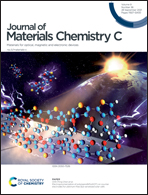Design optimization of CsPbBr3 nanocrystals into zeolite Beta composites as ultra-stable green emitters for backlight display applications†
Abstract
CsPbBr3 nanocrystals (NCs) with highly efficient narrow-band green emission are promising candidates in display applications. However, the poor stability of CsPbBr3 NCs is always a challenge for future development. Herein, we designed and prepared CsPbBr3 NCs encapsulated into zeolite Beta (denoted as CsPbBr3-Beta) composite via an optimized high temperature solid-state method, and the as-obtained power materials exhibited green emission peaking at 520 nm with a narrow full-width at half-maximum (FWHM) of 25 nm and a high photoluminescence quantum yield (∼61%). We further demonstrated the ultra-high luminescent stability of CsPbBr3-Beta composite by treating under a 150 °C treatment, soaking in water over 30 days, as well as applying in 450 nm light-emitting devices (LED) for 20 days. Ultimately, white-light-emitting devices (WLEDs) constructed by the green-emitting CsPbBr3-Beta composite and commercial blue chip and red K2SiF6:Mn4+ phosphor achieved a color gamut of 123.5% National Television System Committee standard (NTSC) and high luminous efficiency (LE = 95 lm W−1). This work highlights the encapsulation process and feasible solid-state reaction methodology to fabricate CsPbBr3 NCs confined in a microporous molecular sieve with high luminescent stability and performance, significantly expanding its great potential to be used in optoelectronic fields.



 Please wait while we load your content...
Please wait while we load your content...